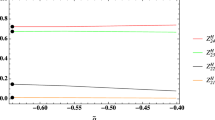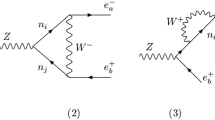Abstract
The newly discovered resonance at 125 GeV has properties consistent with the Standard Model (SM) Higgs particle, although some production and/or decay channels currently exhibit O(1) deviations. We consider scenarios with a new scalar singlet field with couplings to electrically charged vector-like matter, focusing particularly on the case when the singlet mass lies within a narrow ~ few GeV window around the Higgs mass. Such a ‘singlet neighbor’ presents novel mechanisms for modifying the observed properties of the Higgs boson. For instance, even a small amount of the Higgs-singlet mixing can lead to a significant enhancement of the apparent diphoton rate. Alternatively, the Higgs may decay into the nearby singlet, along with a very light, very soft mediator particle, in which case there can be O(1) enhancement to the apparent diphoton rate even for ~ TeV-scale charged vector-like matter. We also explore models in which vector-like fermions mix with the SM leptons, causing the simultaneous enhancement of γγ and suppression of \( \tau \overline{\tau } \) Higgs branching ratios. Our scenario can be tested with the accumulating LHC data by probing for the di-resonance structure of the 125 GeV diphoton signal, as well as the relative shift in the resonance location between the diphoton and four-lepton modes.
Similar content being viewed by others
References
ATLAS collaboration, Observation of an excess of events in the search for the standard model Higgs boson with the ATLAS detector at the LHC, ATLAS-CONF-2012-093 (2012).
J. Incandela, Update on the Higgs boson searches at the LHC, CERN Seminar, July 4, 2012 http://cdsweb.cern.ch/record/1459513 (2012).
CDF and D0 collaborations, S.Z. Shalhout, Higgs - Tevatron, talk at the ICHEP2012, Melbourne Australia, July 9, 2012 (2012).
M.E. Peskin, Comparison of LHC and ILC capabilities for Higgs boson coupling measurements, arXiv:1207.2516 [INSPIRE].
J.F. Gunion, S. Dawson, H.E. Haber and G.L. Kane, The Higgs hunter’s guide, Addison-Wesley, Reading U.S.A. (1990).
A. Djouadi, The anatomy of electro-weak symmetry breaking. I: the Higgs boson in the standard model, Phys. Rept. 457 (2008) 1 [hep-ph/0503172] [INSPIRE].
M. Carena, S. Gori, N.R. Shah and C.E. Wagner, A 125 GeV SM-like Higgs in the MSSM and the γγ rate, JHEP 03 (2012) 014 [arXiv:1112.3336] [INSPIRE].
K. Cheung and T.-C. Yuan, Could the excess seen at 124–126 GeV be due to the Randall-Sundrum radion?, Phys. Rev. Lett. 108 (2012) 141602 [arXiv:1112.4146] [INSPIRE].
Z. Kang, J. Li and T. Li, On naturalness of the (N)MSSM, arXiv:1201.5305 [INSPIRE].
J.-J. Cao, Z.-X. Heng, J.M. Yang, Y.-M. Zhang and J.-Y. Zhu, A SM-like Higgs near 125 GeV in low energy SUSY: a comparative study for MSSM and NMSSM, JHEP 03 (2012) 086 [arXiv:1202.5821] [INSPIRE].
J.J. Heckman, P. Kumar and B. Wecht, The Higgs as a probe of supersymmetric extra sectors, JHEP 07 (2012) 118 [arXiv:1204.3640] [INSPIRE].
A. Azatov, R. Contino, D. Del Re, J. Galloway, M. Grassi and S. Rahatlou, Determining Higgs couplings with a model-independent analysis of H → γγ, JHEP 06 (2012) 134 [arXiv:1204.4817] [INSPIRE].
T. Cohen, D.E. Morrissey and A. Pierce, Electroweak baryogenesis and Higgs signatures, Phys. Rev. D 86 (2012) 013009 [arXiv:1203.2924] [INSPIRE].
L. Wang and X.-F. Han, The recent Higgs boson data and Higgs triplet model with vector-like quark, arXiv:1206.1673 [INSPIRE].
K. Blum, R.T. D’Agnolo and J. Fan, Natural SUSY predicts: Higgs couplings, arXiv:1206.5303 [INSPIRE].
A. Arhrib, R. Benbrik and C.-H. Chen, H → γγ in the complex two Higgs doublet model, arXiv:1205.5536 [INSPIRE].
M. Carena, S. Gori, N.R. Shah, C.E. Wagner and L.-T. Wang, Light Stau phenomenology and the Higgs γγ rate, JHEP 07 (2012) 175 [arXiv:1205.5842] [INSPIRE].
A. Akeroyd and S. Moretti, Enhancement of H to γγ from doubly charged scalars in the Higgs triplet model, Phys. Rev. D 86 (2012) 035015 [arXiv:1206.0535] [INSPIRE].
M. Carena, I. Low and C.E. Wagner, Implications of a modified Higgs to diphoton decay width, JHEP 08 (2012) 060 [arXiv:1206.1082] [INSPIRE].
M.J. Dolan, C. Englert and M. Spannowsky, Higgs self-coupling measurements at the LHC, arXiv:1206.5001 [INSPIRE].
W.-F. Chang, J.N. Ng and J.M. Wu, Constraints on new scalars from the LHC 125 GeV Higgs signal, Phys. Rev. D 86 (2012) 033003 [arXiv:1206.5047] [INSPIRE].
J. Chang, K. Cheung, P.-Y. Tseng and T.-C. Yuan, Distinguishing various models of the 125 GeV boson in vector boson fusion, arXiv:1206.5853 [INSPIRE].
S. Chang, C.A. Newby, N. Raj and C. Wanotayaroj, Revisiting theories with enhanced Higgs couplings to weak gauge bosons, arXiv:1207.0493 [INSPIRE].
M. Montull and F. Riva, Higgs discovery: the beginning or the end of natural EWSB?, arXiv:1207.1716 [INSPIRE].
H. An, T. Liu and L.-T. Wang, 125 GeV Higgs boson, enhanced di-photon rate and gauged U(1) PQ -extended MSSM, arXiv:1207.2473 [INSPIRE].
N. Craig and S. Thomas, Exclusive signals of an extended Higgs sector, arXiv:1207.4835 [INSPIRE].
L.G. Almeida, E. Bertuzzo, P.A. Machado and R.Z. Funchal, Does H → γγ taste like vanilla new physics?, arXiv:1207.5254 [INSPIRE].
P. Draper and D. McKeen, Diphotons from tetraphotons in the decay of a 125 GeV Higgs at the LHC, Phys. Rev. D 85 (2012) 115023 [arXiv:1204.1061] [INSPIRE].
C. Burgess, J. Matias and M. Pospelov, A Higgs or not a Higgs? what to do if you discover a new scalar particle, Int. J. Mod. Phys. A 17 (2002) 1841 [hep-ph/9912459] [INSPIRE].
A.V. Manohar and M.B. Wise, Modifications to the properties of the Higgs boson, Phys. Lett. B 636 (2006) 107 [hep-ph/0601212] [INSPIRE].
S. Chang, R. Dermisek, J.F. Gunion and N. Weiner, Nonstandard Higgs boson decays, Ann. Rev. Nucl. Part. Sci. 58 (2008) 75 [arXiv:0801.4554] [INSPIRE].
I. Low and J. Lykken, Revealing the electroweak properties of a new scalar resonance, JHEP 10 (2010) 053 [arXiv:1005.0872] [INSPIRE].
C. Englert, T. Plehn, M. Rauch, D. Zerwas and P.M. Zerwas, LHC: standard Higgs and hidden Higgs, Phys. Lett. B 707 (2012) 512 [arXiv:1112.3007] [INSPIRE].
B. Batell, S. Gori and L.-T. Wang, Exploring the Higgs portal with 10/fb at the LHC, JHEP 06 (2012) 172 [arXiv:1112.5180] [INSPIRE].
D. Carmi, A. Falkowski, E. Kuflik and T. Volansky, Interpreting LHC Higgs results from natural new physics perspective, JHEP 07 (2012) 136 [arXiv:1202.3144] [INSPIRE].
M. Klute, R. Lafaye, T. Plehn, M. Rauch and D. Zerwas, Measuring Higgs couplings from LHC data, Phys. Rev. Lett. 109 (2012) 101801 [arXiv:1205.2699] [INSPIRE].
J.R. Espinosa, M. Muhlleitner, C. Grojean and M. Trott, Probing for invisible Higgs decays with global fits, JHEP 09 (2012) 126 [arXiv:1205.6790] [INSPIRE].
A. Djouadi, The anatomy of electro-weak symmetry breaking. II. The Higgs bosons in the minimal supersymmetric model, Phys. Rept. 459 (2008) 1 [hep-ph/0503173] [INSPIRE].
G. Branco, P. Ferreira, L. Lavoura, M. Rebelo, M. Sher and J.P. Silva, Theory and phenomenology of two-Higgs-doublet models, Phys. Rept. 516 (2012) 1 [arXiv:1106.0034] [INSPIRE].
V. Silveira and A. Zee, Scalar phantoms, Phys. Lett. B 161 (1985) 136 [INSPIRE].
T. Binoth and J. van der Bij, Influence of strongly coupled, hidden scalars on Higgs signals, Z. Phys. C 75 (1997) 17 [hep-ph/9608245] [INSPIRE].
J. McDonald, Gauge singlet scalars as cold dark matter, Phys. Rev. D 50 (1994) 3637 [hep-ph/0702143] [INSPIRE].
C. Burgess, M. Pospelov and T. ter Veldhuis, The minimal model of nonbaryonic dark matter: a singlet scalar, Nucl. Phys. B 619 (2001) 709 [hep-ph/0011335] [INSPIRE].
D. O’Connell, M.J. Ramsey-Musolf and M.B. Wise, Minimal extension of the standard model scalar sector, Phys. Rev. D 75 (2007) 037701 [hep-ph/0611014] [INSPIRE].
V. Barger, P. Langacker, M. McCaskey, M.J. Ramsey-Musolf and G. Shaughnessy, LHC phenomenology of an extended standard model with a real scalar singlet, Phys. Rev. D 77 (2008) 035005 [arXiv:0706.4311] [INSPIRE].
P.J. Fox, D. Tucker-Smith and N. Weiner, Higgs friends and counterfeits at hadron colliders, JHEP 06 (2011) 127 [arXiv:1104.5450] [INSPIRE].
R. Sato, S. Shirai and T.T. Yanagida, A scalar boson as a messenger of new physics, Phys. Lett. B 704 (2011) 490 [arXiv:1105.0399] [INSPIRE].
I. Low, J. Lykken and G. Shaughnessy, Singlet scalars as Higgs imposters at the large hadron collider, Phys. Rev. D 84 (2011) 035027 [arXiv:1105.4587] [INSPIRE].
I. Low, J. Lykken and G. Shaughnessy, Have we observed the Higgs (imposter)?, arXiv:1207.1093 [INSPIRE].
D. Bertolini and M. McCullough, The social Higgs, arXiv:1207.4209 [INSPIRE].
J.F. Gunion, Y. Jiang and S. Kraml, Could two NMSSM Higgs bosons be present near 125 GeV?, arXiv:1207.1545 [INSPIRE].
J.M. Cline, 130 GeV dark matter and the Fermi gamma-ray line, Phys. Rev. D 86 (2012) 015016 [arXiv:1205.2688] [INSPIRE].
B.A. Dobrescu, G.L. Landsberg and K.T. Matchev, Higgs boson decays to CP odd scalars at the Tevatron and beyond, Phys. Rev. D 63 (2001) 075003 [hep-ph/0005308] [INSPIRE].
ATLAS collaboration, Search for a Higgs boson decaying to four photons through light CP-odd scalar coupling using lumifull of 7 TeV pp collision data taken with ATLAS detector at the LHC, ATLAS-CONF-2012-079 (2012).
C. Englert, M. Spannowsky and C. Wymant, Partially (in)visible Higgs decays at the LHC, arXiv:1209.0494 [INSPIRE].
C. Bird, P. Jackson, R.V. Kowalewski and M. Pospelov, Search for dark matter in B → s transitions with missing energy, Phys. Rev. Lett. 93 (2004) 201803 [hep-ph/0401195] [INSPIRE].
C. Bird, R.V. Kowalewski and M. Pospelov, Dark matter pair-production in B → s transitions, Mod. Phys. Lett. A 21 (2006) 457 [hep-ph/0601090] [INSPIRE].
BaBar collaboration, J. Lees et al., Observation of the rare decay B + → K + π 0 π 0 and measurement of the quasi-two body contributions B + → K *(892)+ π 0, B + → f 0(980)K + and B + → χ c0 K +, Phys. Rev. D 84 (2011) 092007 [arXiv:1109.0143] [INSPIRE].
E. Del Nobile, R. Franceschini, D. Pappadopulo and A. Strumia, Minimal matter at the large hadron collider, Nucl. Phys. B 826 (2010) 217 [arXiv:0908.1567] [INSPIRE].
S. Dawson and E. Furlan, A Higgs conundrum with vector fermions, Phys. Rev. D 86 (2012) 015021 [arXiv:1205.4733] [INSPIRE].
N. Bonne and G. Moreau, Reproducing the Higgs boson data with vector-like quarks, arXiv:1206.3360 [INSPIRE].
A. Joglekar, P. Schwaller and C.E. Wagner, Dark matter and enhanced Higgs to di-photon rate from vector-like leptons, arXiv:1207.4235 [INSPIRE].
M.E. Peskin and T. Takeuchi, Estimation of oblique electroweak corrections, Phys. Rev. D 46 (1992) 381 [INSPIRE].
ALEPH, DELPHI, L3, OPAL, SLD, LEP Electroweak Working Group, SLD Electroweak Group, SLD Heavy Flavour Group collaborations, Precision electroweak measurements on the Z resonance, Phys. Rept. 427 (2006) 257 [hep-ex/0509008] [INSPIRE].
Heavy Flavor Averaging Group collaboration, Y. Amhis et al., Averages of b-hadron, c-hadron and τ -lepton properties as of early 2012, arXiv:1207.1158 [INSPIRE].
Particle Data Group collaboration, C. Amsler et al., Review of particle physics, Phys. Lett. B 667 (2008) 1 [INSPIRE].
D. Choudhury, T.M. Tait and C. Wagner, Beautiful mirrors and precision electroweak data, Phys. Rev. D 65 (2002) 053002 [hep-ph/0109097] [INSPIRE].
ATLAS collaboration, Search for direct slepton and gaugino production in final states with two leptons and missing transverse momentum with the ATLAS detector in pp collisions at \( \sqrt{s}=7 \) TeV, ATLAS-CONF-2012-076 (2012).
J. Alwall, M. Herquet, F. Maltoni, O. Mattelaer and T. Stelzer, MadGraph 5: going beyond, JHEP 06 (2011) 128 [arXiv:1106.0522] [INSPIRE].
N. Arkani-Hamed, K. Blum, R.T. D’Agnolo and J. Fan, 2:1 for naturalness at the LHC?, arXiv:1207.4482 [INSPIRE].
L.M. Carpenter, A. Rajaraman and D. Whiteson, Searches for fourth generation charged leptons, arXiv:1010.1011 [INSPIRE].
T. Sjöstrand, S. Mrenna and P.Z. Skands, PYTHIA 6.4 physics and manual, JHEP 05 (2006) 026 [hep-ph/0603175] [INSPIRE].
J. Conway et al., PGS4, http://physics.ucdavis.edu/~conway/research/software/pgs/pgs4-general.htm.
ATLAS collaboration, G. Aad et al., Expected performance of the ATLAS experiment - Detector, trigger and physics, arXiv:0901.0512 [INSPIRE].
CMS collaboration, G. Bayatian et al., CMS technical design report, volume II: physics performance, J. Phys. G 34 (2007) 995 [INSPIRE].
Author information
Authors and Affiliations
Corresponding author
Additional information
ArXiv ePrint: 1207.6252
Rights and permissions
About this article
Cite this article
Batell, B., McKeen, D. & Pospelov, M. Singlet neighbors of the Higgs boson. J. High Energ. Phys. 2012, 104 (2012). https://doi.org/10.1007/JHEP10(2012)104
Received:
Revised:
Accepted:
Published:
DOI: https://doi.org/10.1007/JHEP10(2012)104




